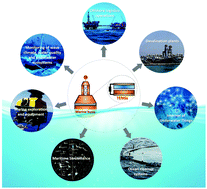Emerging triboelectric nanogenerators for ocean wave energy harvesting: state of the art and future perspectives
Abstract
A triboelectric nanogenerator (TENG) is a new energy harvester that converts small scale mechanical motions into electrical energy by a combination of triboelectrification and electrostatic induction through the periodic contact-separation and/or sliding movement between two tribo-materials with different abilities of gaining or losing electrical charges. This new approach to harvest mechanical energy can produce high power outputs capable of supplying equipment and sensors deployed in remote offshore locations and of supporting offshore activities whilst being able to be used in conjunction with traditional energy harvesting technologies. This review describes the fundamentals of TENGs and the existing energy harvesting modes, with focus on those more suitable for marine applications. Moreover, the equipment and offshore activities whose energy needs can be satisfied by TENGs are described and implementation schemes presented. We conclude that TENGs have high potential for numerous maritime applications, ranging from the demand of electronics used for metocean monitoring, signalling and surveillance, to activities such as offshore aquaculture or oil and gas exploration. The advantages of such systems as an alternative to currently existing solutions are also discussed, along with insights concerning applications that can take advantage of their high efficiency harvesting low amplitude and low frequency wave energy.



 Please wait while we load your content...
Please wait while we load your content...